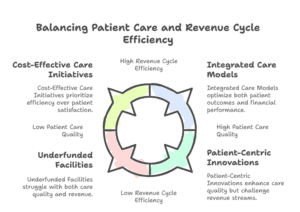In the healthcare industry, providing high-quality patient care while maintaining efficient revenue cycle management (RCM) is crucial for the long-term success of any healthcare organization. While patient care is the primary focus, optimizing revenue cycle processes ensures that the organization remains financially healthy, sustainable, and capable of continuing to offer excellent care. However, achieving a balance between patient satisfaction and financial performance can be challenging.
Let’s explore how healthcare organizations can balance patient care and revenue cycle efficiency to achieve both clinical excellence and financial success.
Why Balancing Patient Care and Revenue Cycle Efficiency is Important
In today’s healthcare environment, the pressure to deliver high-quality care while managing costs has increased. Optimizing RCM processes can improve cash flow, reduce claim denials, and increase reimbursements, ensuring that healthcare organizations stay financially stable. However, it is essential not to compromise patient care in the process. Key factors that highlight the importance of balancing these two elements include:
- Sustainability of operations: Efficient RCM allows healthcare organizations to reinvest in patient care, improving facilities, staffing, and services.
- Enhanced patient experience: Effective RCM processes can streamline administrative tasks, reducing patient wait times and improving their overall experience.
- Compliance and regulations: Healthcare organizations must adhere to financial regulations and insurance requirements to avoid penalties and ensure proper reimbursement for services rendered.
How to Balance Patient Care and Revenue Cycle Efficiency

1. Automate Administrative Processes
Automation of administrative processes is key to improving RCM efficiency while allowing healthcare providers to focus more on patient care. Benefits of automation include:
- Streamlined billing and coding: Automated coding tools ensure that claims are submitted accurately and promptly, reducing the risk of claim denials and speeding up the reimbursement process.
- Faster insurance verification: Automated eligibility verification tools can quickly confirm insurance coverage, allowing healthcare organizations to focus more on providing care rather than managing insurance paperwork.
- Reduced administrative burden: Automating repetitive administrative tasks like patient registration and scheduling frees up staff time, allowing them to focus on patient care.
2. Implement Patient-Centered RCM Practices
Integrating patient-centered practices into RCM can help organizations optimize both patient care and financial performance. These practices include:
- Transparent billing: Providing clear and transparent billing statements helps patients understand their financial responsibilities and reduces confusion about billing charges, which enhances patient satisfaction.
- Flexible payment options: Offering payment plans and online payment portals can help patients manage their financial obligations, ensuring timely payments while keeping them engaged in their care.
- Proactive communication: Keeping patients informed about insurance coverage, out-of-pocket costs, and billing procedures ensures that there are no surprises, improving patient trust and satisfaction.
3. Use Data Analytics to Optimize RCM and Patient Care
Leveraging data analytics can help healthcare organizations make informed decisions that optimize both patient care and revenue cycle performance. Data analytics can be used to:
- Track key performance indicators (KPIs): Monitoring KPIs such as days in accounts receivable, claim denial rates, and patient satisfaction scores allows healthcare organizations to identify areas for improvement in both clinical care and financial performance.
- Identify trends and inefficiencies: Data analytics helps detect trends in patient care, such as treatment delays or service bottlenecks, while also identifying inefficiencies in the revenue cycle, like delayed payments or coding errors.
- Improve resource allocation: Analytics help allocate resources more efficiently by identifying areas where additional support or investment is needed, improving both financial outcomes and patient care quality.
4. Educate and Empower Staff
Educating staff on the importance of balancing patient care and RCM efficiency ensures that everyone within the organization understands their role in achieving both goals. Key strategies include:
- Cross-training staff: Ensuring that clinical and administrative teams are cross-trained in both patient care and RCM helps align goals and fosters a culture of collaboration.
- Engaging frontline staff: Empowering staff to identify and address inefficiencies in both patient care and billing processes can lead to improved operational workflows and better patient outcomes.
- Ongoing training: Providing continuous education on the latest billing practices, coding regulations, and patient care standards helps staff stay informed and capable of managing both aspects effectively.
5. Improve Patient Engagement and Communication
Effective communication is critical for maintaining patient satisfaction while ensuring timely payments. Healthcare providers can improve engagement by:
- Clarifying financial expectations: Communicating the costs of services upfront and addressing patient concerns about billing early in the process can reduce confusion and build trust.
- Offering educational resources: Providing patients with resources to understand their insurance coverage, the services they will receive, and their financial responsibilities can lead to more informed patients and a smoother revenue cycle process.
- Promoting patient advocacy: Ensuring patients have access to a patient advocate or financial counselor can help them navigate their care and financial journey, improving their overall experience and increasing the likelihood of timely payments.
6. Optimize Patient Scheduling and Workflow
Efficient scheduling and patient flow management are essential for providing timely care while maximizing revenue cycle performance. Benefits of optimized scheduling include:
- Reducing wait times: Efficient scheduling systems reduce patient wait times, enhancing their overall experience and satisfaction.
- Maximizing appointment capacity: By efficiently managing appointments, healthcare organizations can maximize the number of patients seen, improving both patient care access and financial performance.
- Reducing no-show rates: Automated reminder systems help reduce missed appointments, which can negatively impact both patient care and revenue.
7. Leverage Technology for Billing and Collections
Investing in billing and collections technology can help streamline the process and reduce administrative overhead, allowing for better care delivery. Key technology tools include:
- Integrated billing systems: Integrated systems that connect patient care data with billing and claims management systems ensure that all patient services are accounted for accurately and reimbursed promptly.
- Patient portals: Providing patients with easy access to their billing information through secure online portals can improve communication and make it easier for patients to manage their payments.
- Automated collections tools: Automated tools for payment reminders, overdue notices, and collections ensure that payments are collected efficiently, reducing delays and improving cash flow without negatively affecting patient care.
Conclusion
Balancing patient care with revenue cycle efficiency is essential for the long-term success of healthcare organizations. By streamlining administrative processes, utilizing data analytics, empowering staff, and maintaining clear communication with patients, healthcare organizations can improve both clinical outcomes and financial performance. With the right strategies and technologies in place, healthcare providers can ensure that patients receive the best possible care while maintaining a healthy revenue cycle.
What People Are Asking
1. How can healthcare organizations balance patient care with financial performance?
By streamlining administrative processes, educating staff, and integrating patient-centered practices into the revenue cycle, healthcare organizations can improve both patient care and financial outcomes.
2. How does data analytics improve patient care and revenue cycle efficiency?
Data analytics allows organizations to track performance, identify inefficiencies, and allocate resources more effectively, leading to better patient care and improved financial performance.
3. What are some strategies to improve patient engagement and reduce billing issues?
Providing clear communication about costs, offering payment options, and using patient portals to track billing information can improve engagement and reduce confusion.
4. How can telemedicine support both patient care and revenue cycle efficiency?
Telemedicine increases accessibility and reduces the need for in-person visits, improving patient care while also optimizing billing and reimbursement processes.
5. How can healthcare organizations reduce no-show rates?
By using automated appointment reminders, offering flexible scheduling options, and improving patient engagement, healthcare organizations can reduce no-show rates and improve both patient care and revenue cycle efficiency.
Disclaimer
For informational purposes only; not applicable to specific situations.
For tailored support and professional services,
please contact Staffingly, Inc. at (800) 489-5877
Email: support@staffingly.com.
About This Blog: This Blog is brought to you by Staffingly, Inc., a trusted name in healthcare outsourcing. The team of skilled healthcare specialists and content creators is dedicated to improving the quality and efficiency of healthcare services. The team passionate about sharing knowledge through insightful articles, blogs, and other educational resources.
 Book a Demo to Build Your Team Today!
Book a Demo to Build Your Team Today!

 Read Case Studies
Read Case Studies 


 Virtual Medical Assistants
Virtual Medical Assistants



